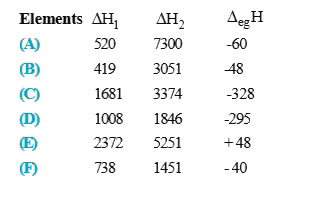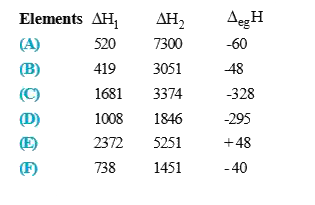What is the significance of the terms — ‘isolated gaseous atom’ and ‘ground state’ while defining the ionization enthalpy and electron gain enthalpy?
Hint : Requirements for comparison purposes.
a. Ionisation enthalpy is the minimum amount of energy required to remove the most loosely bound electron from an isolated gaseous atom so as to covert it into a gasous caton is called ionisation enthalpy. The force with which an electron is attracted by the nucleus of an atom is appreciably affected by the presence of other atoms within its molecule or in the neighbourhood. Therefore, for the purpose of determination of ionisation enthalpy, it is essential that these interatomoic forces of attraction should be minimum. Since in the gaseous state,the atoms are widely separated, therefore, these interatomic forces are minimum. Further since it is not possible to isolate a single atom for the purpose of determination of its ionisation enthalpy, therefore, the interatomic distances are further reduced by carrying out the measurement at a low pressure of the gaseous atom. It is because of these reasons, that the term isolated gaseous atom has been included in the definition of ionisation enthalpy.
b. Electron gain enthalpy is the energy released when an isolated gaseous atom in the ground state accept an extra electron to form the gaseous negative ion. The term isolated gaseous atom has already been explained above. The term ground state here means that the atom must be present in the most stable state, i.e. the ground state. The reason being that when the isolated gaseous atom is in the excited state, lesser amount of energy will be released when it gets converted into gaseous anion after accepting an electron. Therefore, for comparison purposes, the electron gain enthalpies of gaseous atoms must be determined in their respective most stable state, i.e. ground state.
Topper's Solved these Questions
- APPENDIX - INORGANIC VOLUME 1BOOK - CENGAGE CHEMISTRY ENGLISHCHAPTER - APPENDIX - INORGANIC VOLUME 1EXERCISE - Exercise very short
70 Videos
- APPENDIX - INORGANIC VOLUME 1BOOK - CENGAGE CHEMISTRY ENGLISHCHAPTER - APPENDIX - INORGANIC VOLUME 1EXERCISE - Exercise Short
146 Videos
- ALKYNESBOOK - CENGAGE CHEMISTRY ENGLISHCHAPTER - ALKYNESEXERCISE - Exercises (Archives - Analytical and Desriptive Type)
4 Videos
- ATOMIC STRUCTUREBOOK - CENGAGE CHEMISTRY ENGLISHCHAPTER - ATOMIC STRUCTUREEXERCISE - Concept Applicationexercise(4.3)
19 Videos
Similar Questions
What is the significance of the terms-'isolated gaseous atom' and 'ground state' while defining the ionisation enthalpy and electron gain enthalpy?
Hint: Requirements for comparison purposes.
View SolutionAmmong the following, the element having highest ionization enthalpy as positive electron gain enthalpy is
View SolutionDefine electronegativity. How does it differ from electron gain enthalpy?
View SolutionWhat is the basic difference between the terms electron gain enthalpy and electronegativity?
View SolutionWhat is the basic difference between the terms electron gain enthalpy and electronegativity?
View SolutionDiscuss the trend in the following properties of noble gases:
(i) Melting and boiling point.
(ii) Ionization enthalpy.
(iii) Electron affinity. (Electron gain enthalpy)
View SolutionWhich of the following is affected by the stable electron configuration of an atom?
(a) Electronegativity (b) ionisation enthalpy (c ) Electron gain enthalpy
Correct answer is:
View SolutionThe first and second ionization enthalpies and electron gain enthalpy of some elements are as given below:

Which of these elements is the most reactive metal?
View SolutionThe first and second ionization enthalpies and electron gain enthalpy of some elements are as given below:

Which of these elements is the least reactive non-metal?
View SolutionThe first and second ionization enthalpies and electron gain enthalpy of some elements are as given below:

Which of these elements is the most reactive non-metal?
View Solution
